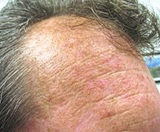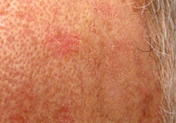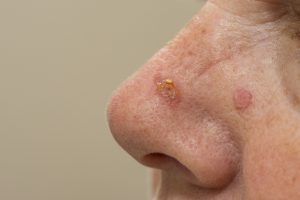By Elizabeth Juneja, RN, CCRP
Some people often wonder what is Actinic Keratosis and how do you know you have it?
Actinic Keratosis can begin as a thick discolored dry patch of skin occurring on the face, scalp, lip, ears, back of hands, forearms, and neck. This is a precancerous lesion which happens after years of sun exposure. If left untreated it can become a squamous cell carcinoma which is one type of skin cancer. Actinic Keratosis is also known as AK or solar keratosis. The spots feel like sandpaper and are flat to slightly raised at times. AKs can be pink, red or brown. They can itch, burn or even bleed at times.
Many people who often suffer from this condition are fair skinned, 40 years or older and may have a health condition that makes them sensitive to UV rays. AKs can come and go depending on sun exposure, that’s why living in this Florida climate makes people with these traits more susceptible. Some of the treatment options involve topical medications, Cryotherapy (most common therapy used which freezes the spots), Curettage (surgical removal) and various chemical peels or lasers. Actinic Keratosis clinical trials may also be an option for those suffering from AK.
Tips:
Having regular checkups with your dermatologist 1-2 times per year. Using sunscreen of 30 SPF or more when outdoors can minimize those risks.
Our skin is the barrier to all the different toxins in our environment that is why we need to take care of it!



Sources:
American Academy of Dermatology. Actinic Keratosis. Retrieved from: https://www.aad.org/public/diseases/scaly-skin/actinic-keratosis
Mayo Clinic. Actinic Keratosis. Retrieved from:
https://www.mayoclinic.org/diseases-conditions/actinic-keratosis/symptoms-causes/syc-20354969


